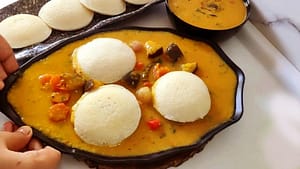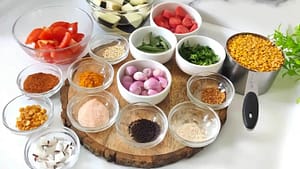Sambar Recipe | Traditional Sambar Recipe | South Indian Sambar
Sambar recipe , a well-loved South Indian lentil and mixed vegetable soup, is crafted with a blend of aromatic spices, tamarind, and fresh coriander leaves. Our household greatly appreciates this go-to sambar recipe, especially when prepared with our own homemade sambar powder. The delightful amalgamation of lentils, vegetables, and spices not only offers a burst of flavors but also presents a nutrient-rich option suitable for lunch, dinner, or even breakfast when paired with Idli, Dosa, Medu Vada, Rava khichdi, or Ven pongal.
Many Type of Samber
1. Potato Sambar Recipe
2. Raw Mango Sambar Recipe
3.Vengaya Sambar Recipe
4. Milagai Killi Potta Sambar Recipe
The origin of sambar
The roots of the authentic sambar recipe can be attributed to Sambhaji Bhosale, the second Chhatrapati of the Maratha Empire and the son of Maratha ruler Shivaji. Sambhaji Bhosale held the reins of the empire from 1681 to 1689, and it is during his time that the original sambar recipe is believed to have originated. Apparently, Sambhaji Maharaj’s head cook took a day off and Sambhaji made the decision to prepare dal for himself.Entering the royal kitchen, he commenced collecting the necessary ingredients for concocting ‘Amti,’ a lentil dish characterized by its thin consistency and tangy flavor. Opting for culinary innovation, Sambhaji chose to explore the use of Toor Dal as a substitute for Moong Dal. Additionally, he replaced tamarind with ‘Kokum,’ a plant known for its acidity-reducing properties, elevating the tangy undertones of the dish.The dish was then offered to the court attendees, who adored it so much that they named it ‘Sambar’, after Sambhaji’s name .
Sambar, referred to as Kuzhambu in Tamil Nadu, stands out as a flavorful lentil-infused vegetable stew prepared with pigeon pea and tamarind-infused broth. This culinary delight enjoys widespread popularity in South Indian, Sri Lankan, and Maldivian gastronomies. Interestingly, the savory stew has found its way into Burmese cuisine, serving as a favored accompaniment to Burmese curries.
History
According to food historian K. T. Achaya, the earliest extant mention of sambar in literature can be dated to the 17th century in Tamil Nadu.
British Indian Restaurant
The ‘Samber’ is a staple of British curry houses, where it is served in the form of a thicker sauce than the original, with meat added to the dish. Typically it is hot, sour, and, like the original dish, contains lentils.
Sambar Recipe Ingredient
1. Toor Dal – 1/2 Cup
2. Water – 3 Cup
3. Turmeric Powder – 1/2 tsp
4. Chopped Beans
5. Chopped Carrot – 1
6. Drum Stick
7. Bottle Gourds – 4 tbsp
8. Brinjal – 1
9.Oil – 1Tablespoon
10.Mustard Seeds – 1 Tablespoon
11.Urad Dal – 1 Tablespoon
12.Curry Leaves – 1 Tablespoon
13.Hink 2 pinch
14.Dry Red chilli – 3
15.Finely Chopped onion – 1
16.Garlic Cloves – 4
17.Chopped Green chilli – 2
18.Finely Chopped Tomato – 2
19.Onion Patels – 1 Tablespoon
20.Turmeric Powder – 1/4 Tablespoon
21.Kashmiri Red chilli – 1 Tablespoon
22.Tamarind Pulp water – 3 Tablespoon
23.Crushed Jaggery – 1 Tablespoon
24.Sambar Masala – 2Tablespoon
25.Water – 1/2 cup
26.Salt as per taste
27.1 Tablespoon Crushed Jaggery
28.Bottle Gourds 1
How to make delicious and healthy sambar at home for four people Sambar takes about forty minutes to make.
Instructions
1. To Home make authentic Sambar first take 1/2 cup of Toor dal and soak it into the water for 1/2 hour.
2. 2 Now place a pan on flame and add soaked Toor dal 3 cups of water, and 1/2 tsp of turmeric powder into it.
3. Than , Now take a small steel bowl and add 2 tbsp of chopped beans, 1 chopped carrot, 7 to 8 pieces of drum stick, 4 tbsp of chopped bottle gourd, 1 brinjal to it and this vegetable bowl into the mid cooker and add 2 drops of oil in dal to avoid water oozing out.
4. Now close the lid and cook for 4 to 5 whistles on medium flame.
5. Now place a pan on flame and add 2 tbsp of oil and heat.
6. After oil heat well then add 1 tsp of mustard seeds, 1 tsp of black gram/ urad dal, 1 tbsp of curry leaves. 2 pinches of Asafoetida(Hink) and add 3 dry red chilies and saute everything well on medium flame until golden.
7. add 1 finely chopped onion, and saute well until transparent.
8. Now add 3 to 4 chopped garlic cloves, 2 finely chopped green chili, and saute everything on medium flame and add 2 finely chopped tomatoes and roast well.
9. After tomatoes cooked well then add 1 tbsp of onion petals and fry well.
10. add 1/4 tsp of turmeric powder, 1 tsp of Kashmiri red chili powder, and mix well.
11. Now add 3 tbsp of tamarind pulp water and mix everything well and add 3 tbsp of tamarind pulp water and mix everything well.
12. Now add 1 tbsp of crushed jaggery and mix well.
13. Now add all cooked vegetables and roast well.
14. add 2 tbsp of sambar masala powder and mix well and cook until it starts releasing the oil & add cooked dal to it and mix well.
15. 15.Now add 1/2 cup of water and salt as per taste and mix everything well and boil.
16. Now turn off the flame and your delicious Sambar is ready and you can enjoy it.
FAQ’S
1.How can I make sambar taste better?
Ans: Ensure that the boiled toor dal is thoroughly mashed in the sambar. Once the flame is turned off, incorporate a generous amount of fresh coconut oil or ghee to elevate the flavor of the sambar. Additionally, boil tomatoes and blend them into a pulp, mixing it with the boiled toor dal to impart a vibrant and enticing hue to the sambar.
2. Is sambar considered a traditional dish?
Ans : The narrative suggests that the authentic recipe for sambar, a dish deeply rooted in Tamil Nadu cuisine, can be attributed to Sambhaji, the son of Maratha ruler Shivaji. According to legend, Sambhaji, one of the Maratha rulers, supposedly tried to prepare dal on his own when his head chef was absent.
3. Why is it called sambar?
Ans: Shahji utilized tamarind and added vegetables to prepare Amti dal. When Shivaji’s son, Sambhaji, visited him, Shahji served this flavorful curry. Impressed by the dish, Sambhaji inquired about its ingredients. Consequently, Shahji named the dish after Sambhaji, and it has been known as Sambar ever since.

